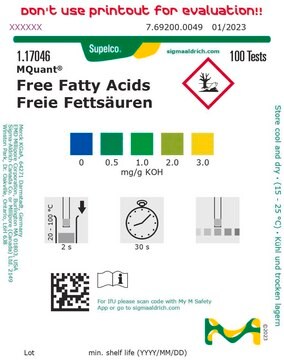Key Documents
MAK338
Fatty Acid Extraction Kit, High Standard
sufficient for 40 extractions
Synonim(y):
Lipid Extraction Kit
About This Item
Polecane produkty
zastosowanie
sufficient for 40 extractions
charakterystyka ekologicznej alternatywy
Waste Prevention
Learn more about the Principles of Green Chemistry.
sustainability
Greener Alternative Product
moc wejściowa
plasma
food(s) (oil)
blood
tissue extract(s)
food(s)
serum
Zastosowanie
cosmetics
food and beverages
sample preparation
kategoria ekologicznej alternatywy
powiązane choroby
cancer
temp. przechowywania
room temp
Opis ogólny
When extracting fatty acids at normal or high levels, such as in food matrices, use the MAK338 Fatty Acid Extraction Kit. This kit produces stronger signals. When extracting fatty acids at low or very low levels, such as in cellular matrices, use the MAK174 Fatty Acid Extraction Kit. If in doubt about which kit to use, use MAK338. The Folch method has been conventionally used to extract lipids containing fatty acids from biological samples, using chloroform, methanol, and water to separate lipids from aqueous-soluble compounds. In this procedure, lipids are retained in the lower chloroform layer; whereas, aqueous-soluble compounds are retained in the upper methanol-water layer. The sample is then centrifuged to achieve uniform separation and the bottom chloroform layer is transferred with a pipette to a new test tube.
The Fatty Acid Extraction Kit shortens this extraction process by eliminating the need to prepare solvents and standards, centrifugation, and pipetting. Once the sample is homogenized and dissolved in the Extraction Solvent supplied in the kit, it is inverted twice and poured into the syringe containing a filter, which preferentially elutes the chloroform layer containing total lipids. A portion of the total lipid extract containing fatty acids can then be transesterified for GC-FID analysis.
We are committed to bringing you Greener Alternative Products, which adhere to one or more of The 12 Principles of Greener Chemistry. This product reduces solvent waste over traditional methods. Find details here.
Zastosowanie
- Lipid Analysis
- Lipidomics Research
Cechy i korzyści
Przydatność
Inne uwagi
produkt powiązany
Hasło ostrzegawcze
Danger
Zwroty wskazujące rodzaj zagrożenia
Zwroty wskazujące środki ostrożności
Klasyfikacja zagrożeń
Acute Tox. 3 Inhalation - Acute Tox. 4 Dermal - Acute Tox. 4 Oral - Aquatic Chronic 3 - Carc. 2 - Eye Irrit. 2 - Flam. Liq. 2 - Repr. 2 - Skin Irrit. 2 - STOT RE 1 - STOT SE 1 - STOT SE 3
Organy docelowe
Central nervous system, Eyes, Liver,Kidney
Kod klasy składowania
3 - Flammable liquids
Temperatura zapłonu (°F)
95.0 °F
Temperatura zapłonu (°C)
35 °C
Certyfikaty analizy (CoA)
Poszukaj Certyfikaty analizy (CoA), wpisując numer partii/serii produktów. Numery serii i partii można znaleźć na etykiecie produktu po słowach „seria” lub „partia”.
Masz już ten produkt?
Dokumenty związane z niedawno zakupionymi produktami zostały zamieszczone w Bibliotece dokumentów.
Klienci oglądali również te produkty
Nasz zespół naukowców ma doświadczenie we wszystkich obszarach badań, w tym w naukach przyrodniczych, materiałoznawstwie, syntezie chemicznej, chromatografii, analityce i wielu innych dziedzinach.
Skontaktuj się z zespołem ds. pomocy technicznej










